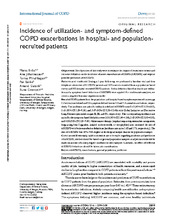| dc.contributor.author | Erdal, Marta | en_US |
| dc.contributor.author | Johannessen, Ane | en_US |
| dc.contributor.author | Eagan, Tomas Mikal | en_US |
| dc.contributor.author | Bakke, Per S. | en_US |
| dc.contributor.author | Gulsvik, Amund | en_US |
| dc.contributor.author | Grønseth, Rune | en_US |
| dc.date.accessioned | 2017-04-05T08:45:10Z | |
| dc.date.available | 2017-04-05T08:45:10Z | |
| dc.date.issued | 2016-09 | |
| dc.Published | The International Journal of Chronic Obstructive Pulmonary Disease 2016, 11(1):2099-2108 | eng |
| dc.identifier.issn | 1178-2005 | |
| dc.identifier.uri | https://hdl.handle.net/1956/15675 | |
| dc.description.abstract | Objectives: The objectives of this study were to estimate the impact of recruitment source and outcome definition on the incidence of acute exacerbations of COPD (AECOPD) and explore possible predictors of AECOPD. Patients and methods: During a 1-year follow-up, we performed a baseline visit and four telephone interviews of 81 COPD patients and 132 controls recruited from a population-based survey and 205 hospital-recruited COPD patients. Both a definition based on health care utilization and a symptom-based definition of AECOPD were applied. For multivariate analyses, we chose a negative binomial regression model. Results: COPD patients from the population- and hospital-based samples experienced on average 0.4 utilization-defined and 2.9 symptom-defined versus 1.0 and 5.9 annual exacerbations, respectively. The incidence rate ratios for utilization-defined AECOPD were 2.45 (95% CI 1.22–4.95), 3.43 (95% CI 1.59–7.38), and 5.67 (95% CI 2.58–12.48) with Global Initiative on Obstructive Lung Disease spirometric stages II, III, and IV, respectively. The corresponding incidence rate ratios for the symptom-based definition were 3.08 (95% CI 1.96–4.84), 3.45 (95% CI 1.92–6.18), and 4.00 (95% CI 2.09–7.66). Maintenance therapy (regular long-acting muscarinic antagonists, long-acting beta-2 agonists, inhaled corticosteroids, or theophylline) also increased the risk of AECOPD with both exacerbation definitions (incidence rate ratios 1.65 and 1.73, respectively). The risk of AECOPD was 59%–78% higher in the hospital sample than in the population sample. Conclusion: If externally valid conclusions are to be made regarding incidence and predictors of AECOPD, studies should be based on general population samples or adjustments should be made on account of a likely higher incidence in other samples. Likewise, the effect of different AECOPD definitions should be taken into consideration. | en_US |
| dc.language.iso | eng | eng |
| dc.publisher | Dovepress | eng |
| dc.rights | Attribution CC BY | eng |
| dc.rights.uri | https://creativecommons.org/licenses/by-nc/3.0/ | eng |
| dc.subject | COPD | eng |
| dc.subject | exacerbations | eng |
| dc.subject | general population | eng |
| dc.subject | predictors | eng |
| dc.title | Incidence of utilization- and symptom-defined COPD exacerbations in hospital- and population-recruited patients | en_US |
| dc.type | Peer reviewed | |
| dc.type | Journal article | |
| dc.date.updated | 2016-12-15T12:45:52Z | |
| dc.description.version | publishedVersion | en_US |
| dc.rights.holder | Copyright 2016 the authors | |
| dc.identifier.doi | https://doi.org/10.2147/copd.s108720 | |
| dc.identifier.citation | The International Journal of Chronic Obstructive Pulmonary Disease 2016, 11 (1), 2099-2108. | |

